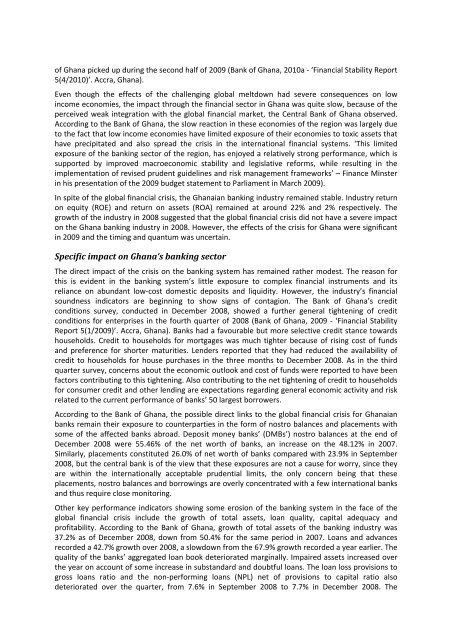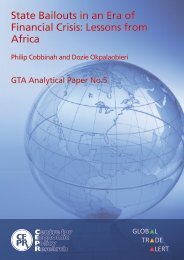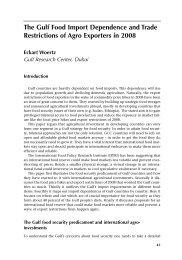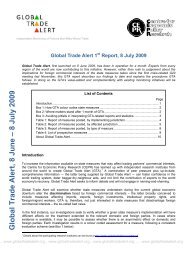You also want an ePaper? Increase the reach of your titles
YUMPU automatically turns print PDFs into web optimized ePapers that Google loves.
of Ghana picked up during the second half of 2009 (Bank of Ghana, 2010a ‐ ‘Financial Stability Report5(4/2010)’. Accra, Ghana).Even though the effects of the challenging global meltdown had severe consequences on lowincome economies, the impact through the financial sector in Ghana was quite slow, because of theperceived weak integration with the global financial market, the Central Bank of Ghana observed.According to the Bank of Ghana, the slow reaction in these economies of the region was largely dueto the fact that low income economies have limited exposure of their economies to toxic assets thathave precipitated and also spread the crisis in the international financial systems. ‘This limitedexposure of the banking sector of the region, has enjoyed a relatively strong performance, which issupported by improved macroeconomic stability and legislative reforms, while resulting in theimplementation of revised prudent guidelines and risk management frameworks’ – Finance Minsterin his presentation of the 2009 budget statement to Parliament in March 2009).In spite of the global financial crisis, the Ghanaian banking industry remained stable. Industry returnon equity (ROE) and return on assets (ROA) remained at around 22% and 2% respectively. Thegrowth of the industry in 2008 suggested that the global financial crisis did not have a severe impacton the Ghana banking industry in 2008. However, the effects of the crisis for Ghana were significantin 2009 and the timing and quantum was uncertain.Specific impact on Ghana’s banking sectorThe direct impact of the crisis on the banking system has remained rather modest. The reason forthis is evident in the banking system’s little exposure to complex financial instruments and itsreliance on abundant low‐cost domestic deposits and liquidity. However, the industry’s financialsoundness indicators are beginning to show signs of contagion. The Bank of Ghana’s creditconditions survey, conducted in December 2008, showed a further general tightening of creditconditions for enterprises in the fourth quarter of 2008 (Bank of Ghana, 2009 ‐ ‘Financial StabilityReport 5(1/2009)’. Accra, Ghana). Banks had a favourable but more selective credit stance towardshouseholds. Credit to households for mortgages was much tighter because of rising cost of fundsand preference for shorter maturities. Lenders reported that they had reduced the availability ofcredit to households for house purchases in the three months to December 2008. As in the thirdquarter survey, concerns about the economic outlook and cost of funds were reported to have beenfactors contributing to this tightening. Also contributing to the net tightening of credit to householdsfor consumer credit and other lending are expectations regarding general economic activity and riskrelated to the current performance of banks’ 50 largest borrowers.According to the Bank of Ghana, the possible direct links to the global financial crisis for Ghanaianbanks remain their exposure to counterparties in the form of nostro balances and placements withsome of the affected banks abroad. Deposit money banks’ (DMBs’) nostro balances at the end ofDecember 2008 were 55.46% of the net worth of banks, an increase on the 48.12% in 2007.Similarly, placements constituted 26.0% of net worth of banks compared with 23.9% in September2008, but the central bank is of the view that these exposures are not a cause for worry, since theyare within the internationally acceptable prudential limits, the only concern being that theseplacements, nostro balances and borrowings are overly concentrated with a few international banksand thus require close monitoring.Other key performance indicators showing some erosion of the banking system in the face of theglobal financial crisis include the growth of total assets, loan quality, capital adequacy andprofitability. According to the Bank of Ghana, growth of total assets of the banking industry was37.2% as of December 2008, down from 50.4% for the same period in 2007. Loans and advancesrecorded a 42.7% growth over 2008, a slowdown from the 67.9% growth recorded a year earlier. Thequality of the banks’ aggregated loan book deteriorated marginally. Impaired assets increased overthe year on account of some increase in substandard and doubtful loans. The loan loss provisions togross loans ratio and the non‐performing loans (NPL) net of provisions to capital ratio alsodeteriorated over the quarter, from 7.6% in September 2008 to 7.7% in December 2008. The









